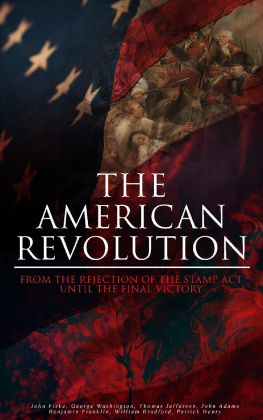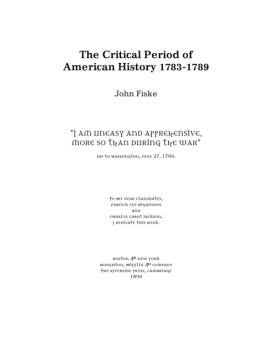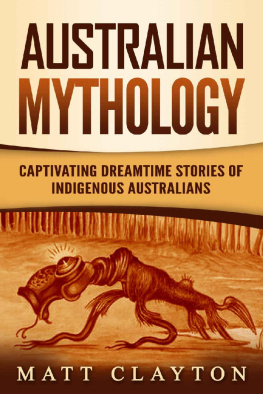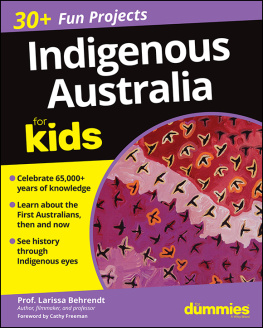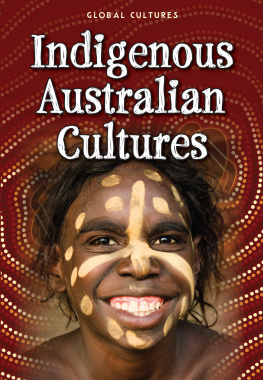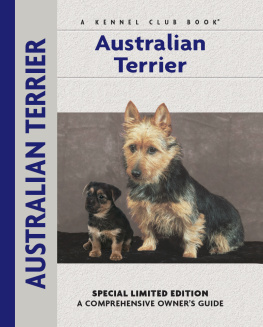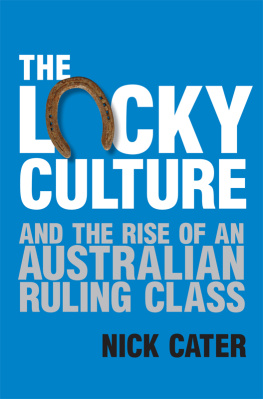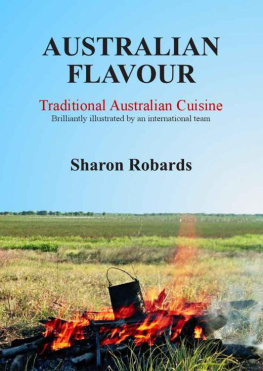ROUTLEDGE LIBRARY EDITIONS: CULTURAL STUDIES
Volume 5
MYTHS OF OZ
Myths of Oz
Reading Australian Popular Culture
John Fiske, Bob Hodge and Graeme Turner
First published in 1987 by Allen & Unwin
This edition first published in 2017
by Routledge
2 Park Square, Milton Park, Abingdon, Oxon OX14 4RN
and by Routledge
711 Third Avenue, New York, NY 10017
Routledge is an imprint of the Taylor & Francis Group, an informa business
1987 John Fiske, Bob Hodge and Graeme Turner
All rights reserved. No part of this book may be reprinted or reproduced or utilised in any form or by any electronic, mechanical, or other means, now known or hereafter invented, including photocopying and recording, or in any information storage or retrieval system, without permission in writing from the publishers.
Trademark notice : Product or corporate names may be trademarks or registered trademarks, and are used only for identification and explanation without intent to infringe.
British Library Cataloguing in Publication Data
A catalogue record for this book is available from the British Library
ISBN: 978-1-138-69145-2 (Set)
ISBN: 978-1-315-45997-4 (Set) (ebk)
ISBN: 978-1-138-20161-3 (Volume 5) (hbk)
ISBN: 978-1-315-51141-2 (Volume 5) (ebk)
Publisher's Note
The publisher has gone to great lengths to ensure the quality of this reprint but points out that some imperfections in the original copies may be apparent.
Disclaimer
The publisher has made every effort to trace copyright holders and would welcome correspondence from those they have been unable to trace.
MYTHS OF OZ
Reading Australian Popular Culture
John Fiske Bob Hodge Graeme Turner
Boston
ALLEN & UNWIN
London Sydney Wellington
Copyright 1987 by John Fiske, Bob Hodge and Graeme Turner
All rights reserved.
Allen & Unwin, Inc.
8 Winchester Place, Winchester, MA 01890, USA.
The U.S. Company of Unwin Hyman Ltd
P.O. Box 18, Park Lane, Hemel Hempstead, Herts HP2 4TE, UK
40 Museum Street, London WC1A 1LU, UK
37/39 Queen Elizabeth Street, London SE1 2QB, UK
Allen & Unwin Australia Pty Ltd,
8 Napier Street, North Sydney, NSW 2060, Australia
Allen & Unwin (New Zealand) Ltd, in association with the Port Nicholson Press Ltd
Private Bag, Wellington, New Zealand
Library of Congress Cataloging-in-Publication Data
Fiske, John.
Myths of Oz.
(Media and popular culture; 2)
Bibliography: p.
Includes index.
1. AustraliaPopular culture. I. Hodge, Bob (Robert Ian Vere) II. Turner, Graeme. III. Title. IV. Series.
DU107.F53 1987 994.06'3 87-12648
ISBN 0-04-330391-9
ISBN 0-04-306005-6 (pbk.)
British Library Cataloguing in Publication Data
Fiske, John.
Myths of Oz: reading Australian popular culture.
1. AustraliaSocial life and customs
I. Title II. Hodge, Robert III. Turner, Graeme
994.06'3 DU107
ISBN 0-04-330391-9
ISBN 0-04-306005-6 Pbk
Set in 10/12pt Stempel Garamond by Asco Trade Typesetting Ltd
Printed in Hong Kong
We wrote this book out of a sense of puzzlement, which many Australians must feel about their country and its culture. From all sides we had been hearing the long-established, traditional criticism bewailing the lack of an Australian culture. Yet this wasn't at all how it felt for us as typical-enough denizens of Australia, living in this self-styled cultural desert, this culture which we're told does not exist. It wasn't that we saw nothing to criticise in Australian life and culture. But the Australia we lived in had a richness and diversity that was incompatible with the Australia of the culture critics.
We suspected that part of the problem came from opposing definitions of 'culture'. The Knocker tradition started from an elitist view of culture. It yearned for Australia to be seen as the Athens of the south, astounding European visitors with the number of masterpieces of art, music and literature. But there are other definitions of culture that are more populist and more comprehensive. These definitions see culture as concerned with the whole way of life of a people, their customs and rituals, their pastimes and pleasures, including not only the arts but also practices such as sport and going to the beach.
To us it seemed clearly an advance to acknowledge the vitality and interest of Australian popular culture. But the dichotomy still felt unsatisfactory. We didn't want to affirm everything in Australian popular life, any more than we wanted to reject high culture in toto. The contradictions we were aware of didn't seem to be situated exclusively between high culture and popular culture. Contradiction seems to be more endemic. It was present in both domains of culture. It was even something we saw in very particular aspects of the culture.
The only way we could make sense of these contradictions was to emphasise culture as itself dynamic, to see Australian culture not as a static collection of items but as a play of forces. We saw it as a set of ways of constructing meanings, not as specific objects or artefacts. In this view its meanings are not fixed and its values are not common. Even with such familiar cultural landmarks as the pub or the beach, the stereotype judgments ignore the creative role of the users of these cultural forms. We think they are best seen as sites where Australians construct (and deconstruct) a plenitude of meanings, using a multitude of practicesnot a single meaning with a single value.
We came to the view that our greatest problem had been an unexamined belief in a monolithic Australian culture. Every previous attempt to pin it down in a single definition seemed to miss this most important point. Keith Hancock's Australia, Russel Ward's Australian Legend, Donald Horne's Lucky Country, Ronald Conway's Great Australian Stupor and Craig McGregor's Profile of Australia offer different definitions and prescriptions, but they all assume that that's what a book on Australian culture ought to be trying to do; they try to discover a single comprehensive and distinctive 'truth' about Australian society and the Australian character. This truth is then evaluated, with exhortations or forebodings assembled in the final chapter.
In our book we have no comprehensive definition of Australian culture, and instead we hope to offer a fruitful way of interpreting its various aspects. This takes the form of a series of particular 'readings'. Through these readings we want to demonstrate the richness of meaning that can be found in Australian culture even at points where so many critics have tried to persuade their compatriots that the only meanings to be found are trivial or obnoxious.
The approach we adopted draws on an important tradition in cultural studies called semiotics: the study of systems of signs. We won't be giving a systematic or technical exposition of semiotics, and our readings stand or fall by their own merits, not by appeal to some theory. But some of the methods of semiotics are simple and accessible, yet powerful. One is the notion of 'reading' itself. In Myths of Oz we say we are 'reading' Australian culture. The analogy with reading books is a fruitful one. It encourages a close analysis of the kind that is normally reserved for literary texts, extending it to cultural products such as film and television and to cultural practices, rituals and behaviours.



